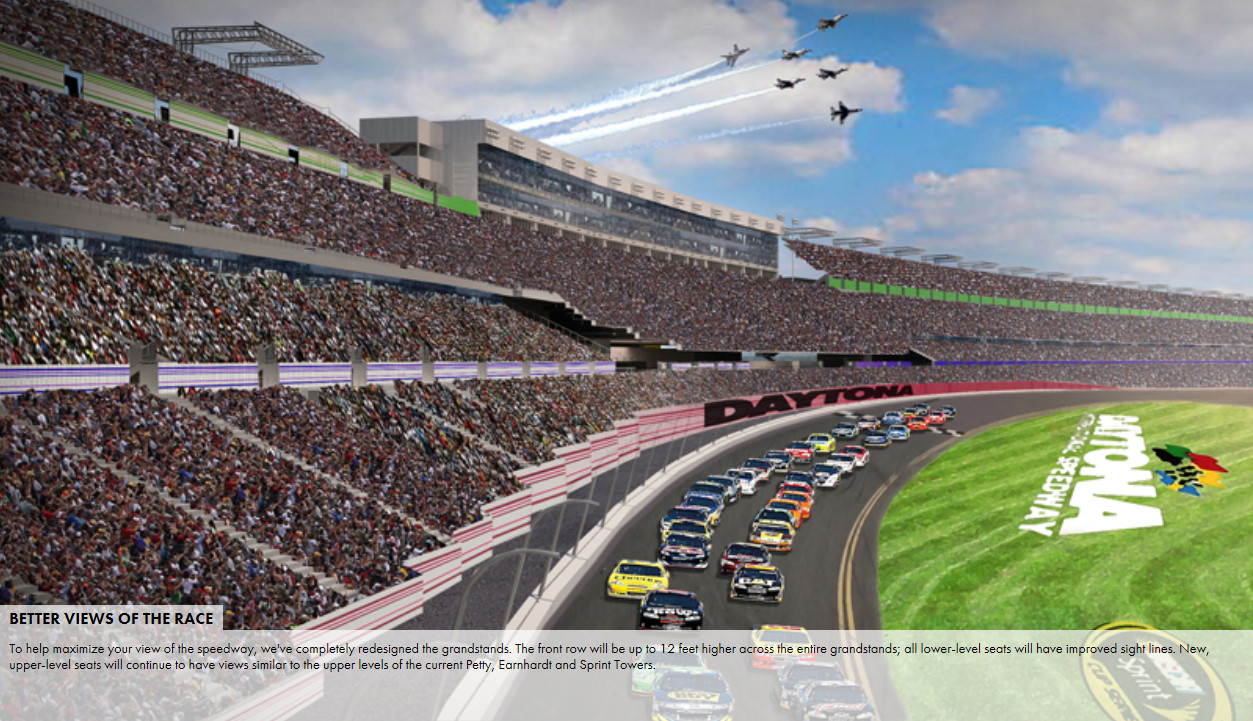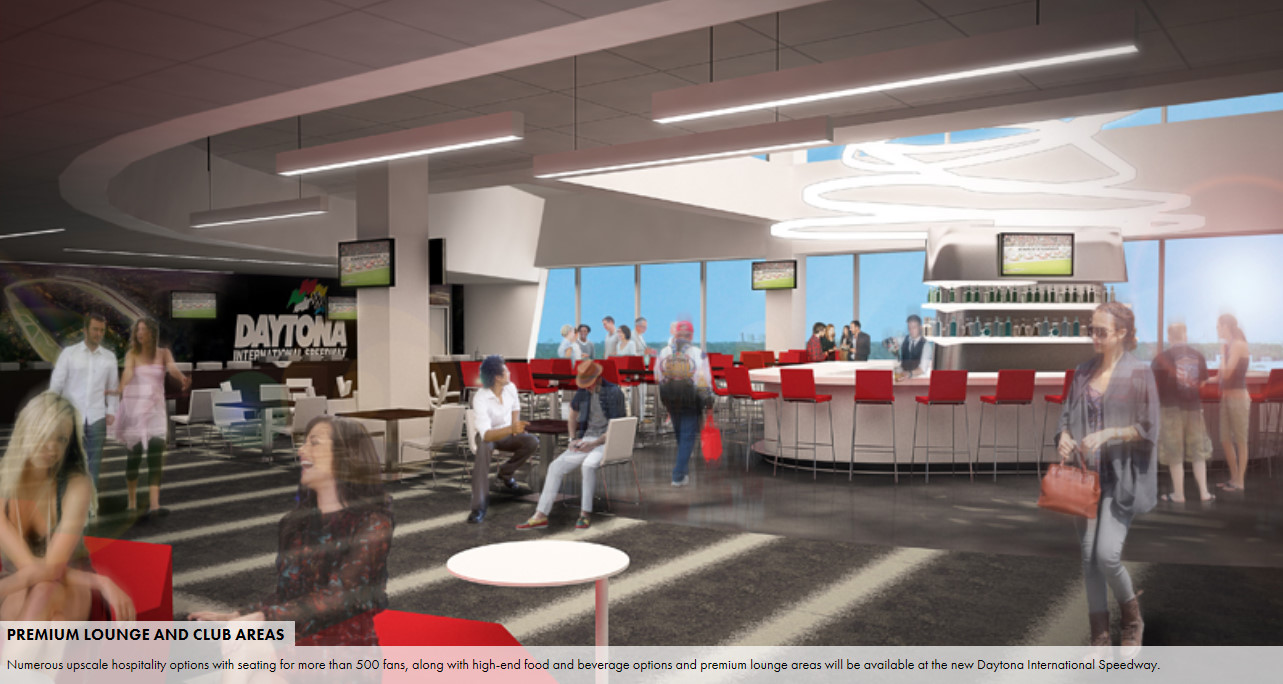NASCAR fans will get first look at Daytona changes during Speedweeks
 |
| View from the inside of the track |
DAYTONA BEACH – It's a common marketing tool used for any type of renovation project. The "Before and After" photo is basic stuff.
Far from common, however, is an opportunity to see the "Before and After" simultaneously as it folds and unfolds.
At Daytona International Speedway, no one has to produce giant, glitzy, colorful renderings of what's ahead for race fans in 2016 and beyond. Over the next couple of weeks, they'll be able to see it – at least enough of it to draw an undeniable image – in all of its steel-enforced, towering, sprawling expanse.
Ironically, all of that steel and concrete is stretched and poured in the name of comfort.
 |
| From outside the 4th turn |
Daytona Rising, the Speedway's mammoth renovation effort, which carries a reported price tag of $400 million, this week will get the first kick-the-tires moment regarding its true purpose: To breathe new life into the Speedway experience, and by extension NASCAR, by creating the first racing "stadium" that rivals the game-day atmosphere and amenities enjoyed by the modern sports fan who has come to expect certain comforts.
That, Speedway and NASCAR leaders assume, will be good for business.
"Obviously, ticketing is the most important thing," Speedway resident Joie Chitwood III said this past week. "We did this for a reason – to make sure fans keep attending events. Selling these seats is very important."
Chitwood and Speedway spokesman Andrew Booth led a few people on a comparison tour, first through the 40,000-seat section of Daytona Rising – the western stretch of the grandstands – and then into what might be described as the Speedway's "historic district," except no one is bothering with beautification efforts at this point.
 |
| Suites |
"Everything we did is big," Chitwood said while walking the new grandstands, which include four levels of seating, permanent concession areas, gathering areas ("neighborhoods"), modern restrooms (hey, guys, no more troughs!), escalators, TV screens practically everywhere, and fan-friendly signage Chitwood doesn't need to point out, but does anyway.
"They'd do the signs and say, 'here's the size,' and we'd say, 'we want them bigger,' " Chitwood said.
Eventually, of course, the most important factor in the purchase of a seat is the seat itself. Always high on the list of Daytona Rising amenities is this: Seats will be 20 and 21 inches wide, depending on the section where you sit. That's 3-to-5 inches wider than the variety of seats they replaced. The new seats fold and include large cup holders. The grandstands are also pitched at such an angle that no one should have to stand to see over the head in front of them (though they will, of course).
All of these things looked great on paper, and hold up to scrutiny in person, but the big awakening comes when you leave the "After" and revisit the "Before." Walking from Daytona Rising and into what'll be next to join "Daytona Razing" – the oldest section of grandstands, near the start/finish line – gives the vibe of leaving the polished town square and stepping inside a relic from FDR's Public Works Administration.
 |
| View from under the grandstands |
"Look at the box TV," said Booth, pointing to a hanging television under the grandstands – a nice amenity in its day, but now looking like something you'd find in the deepest corners of an estate sale.
That seating section, first erected in 1958 and opened in 1959, will remain in place – and in play – for one final Speedweeks. It's part of the 60,000-plus "Before" seats that will be systematically removed and replaced between March and next January's grand opening.
The fans who will utilize the older sections at Daytona will have some chances to sample the new arrangements during Speedweeks. Except for the Feb. 22 Daytona 500, the first level of the completed 40,000-seat section will include some general-admission seating, with the upper levels selling as reserved seating. Next Sunday, during Daytona 500 pole qualifying, all of the 40,000 seats will be general admission.
Following the first weekend of racing – Saturday's 75-lap Sprint Unlimited and 80-lap ARCA race, Sunday's qualifying – Chitwood is banking on rave reviews from the Daytona Rising samplers. He got a sprinkling of it during last month's Rolex 24 weekend, but knows the NASCAR segment of Speedweeks is a much bigger attention-getter.
"Coming out of the Rolex, everybody was talking about it," Chitwood said. "I've never seen so many people in our grandstands for the Rolex. We got some great attention for it. I would expect on Monday (Feb. 16), after qualifying, we're going to get some great comments – pictures posted, tweeting, you name it, because people will be roaming around."
If the Speedway is a picture of evolution during this Speedweeks, it'll look like a midpoint picture of urban renewal when NASCAR returns in July. The entire center section of grandstands – including control tower, press box, suites – will be gone, with the void flanked by the western and eastern completions of Daytona Rising. The 40,000 new seats in the west will be joined by a completed 10,000-seat section in the east, making for a scaled-down Coke Zero 400 in terms of attendance.
"That's when we'll clearly be challenged," Chitwood said. "We have a plan, but when you think about it, nothing in the middle. Everybody understands the challenge of July. We'll have to be accommodating to make it work. The sequencing and logistics of that … this summer, we'll be hustling."
When New York's Yankee Stadium was fully renovated in the mid-1970s, the Yankees shared Shea Stadium with the cross-town Mets for two years. When Soldier Field was rebuilt in 2002, the Chicago Bears played at the University of Illinois. There are no contingency plans for hosting an automobile race, on a 2.5-mile track, at an alternate location. The show goes on, which is what makes Daytona Rising so unique.
"I think 2015 is a tougher year than '16 because of the hybrid model," Chitwood said.
"If we can get through this with a hybrid of 60,000 old seats and 40,000 new seats, with some interesting ways to get you through the injectors and get you to your seats, when all that construction is gone next year and you have big, massive entrance ways … we're gonna earn it in '15, and in '16 we can really enjoy and celebrate the opening. That's the goal." Daytona Beach News Journal
